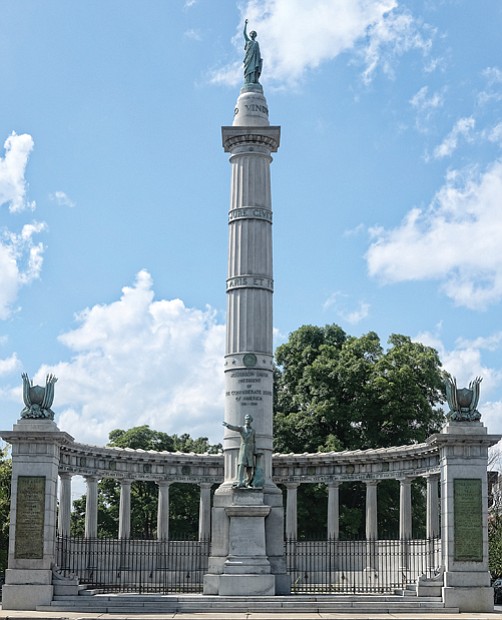Davis must go
Commission recommends removing Confederate president’s statue, but not others
Jeremy M. Lazarus | 7/5/2018, 6 a.m. | Updated on 7/10/2018, 12:56 p.m.
Baltimore, New Orleans, Louisville, Ky., and even Memphis, Tenn., have gotten rid of their statues of racist Confederate traitors who fought to keep black people enslaved.
So have 26 other cities.
But Richmond will not join them in removing those in-your-face symbols of white supremacy and black suppression.
Instead, it expects to keep them in place to influence future generations.
At least, that’s the recommendation from the ten-member Monument Avenue Commission that Mayor Levar M. Stoney set up last June to consider what to do with the statues with which Richmond has been identified for more than a century.
Capping an 11-month study, the commission led by Christy Coleman, CEO of the American Civil War Museum, and Dr. Gregg Kimball of the Library of Virginia, issued a 115-page report Monday laying out its proposals.
While the commission did call for removing the monument to Confederate President Jefferson Davis, it made clear that the city would need to clear a series of legal hurdles, including changing the city’s master plan.
“Of all the statues, this one is most unabashedly Lost Cause in its design and sentiment,” the commission wrote, referring to the post-Civil War movement to erect statues and create reverence for Confederate losers while erecting Jim Crow segregation laws and barriers to voting to keep black people as third-class citizens.
The commission included two members of City Council, Andreas Addison, 1st District, and Kim B. Gray, 2nd District.
The Free Press, which has called for the removal of the statues, had predicted last year that the commission would call for signage. In a June 29, 2017, editorial after the commission was appointed, the Free Press decried the idea of putting “signs, historic markers or additional statues of the towering racists on horseback would be an affront … It would be like putting lipstick on a pig. It doesn’t work, and it isn’t pretty.”
Mayor Stoney praised the commission for its work and said he would study the report before moving forward with proposals to carry out the ideas of the commission, which is a study group without authority. The City Charter hands responsibility for statues to the Planning Commission and one of its arms, the Public Art Commission.
“Richmond has a long, complex and conflicted history, and the Confederate statues on Monument Avenue represents a shameful part of our past,” Mayor Stoney stated in responding to the report’s release.
“As I have said before, the statues on this beautiful street are Lost Cause myth and deception masquerading as history. They are monuments to Jim Crow that do not reflect the qualities of diversity, tolerance and equality we celebrate as values in our city today.
In his view, “the Commission’s report is unequivocal in its affirmation that there is an overwhelming desire and belief (that the statues) should not remain as they currently are. Something needs to change, and I could not agree more.”
Last year, after forming the commission, he had said he could support removal of the statues, but he has made it clear that any proposals he makes would follow the commission’s recommendations, even though they are not binding.
Others, though, found the report to be the kind of compromising half-measure that they believe is typical of Richmond.
Among them is Art Burton, founder and director of the Kinfolk Community Empowerment Center that works to uplift public housing residents. Mr. Burton also is an outspoken supporter of getting rid of the statues.
“Disappointing” is how he described the report.
He said that the decision to call for removal of the Jefferson Davis statue enabled the commission to avoid the centerpiece statue of Robert E. Lee.
“That statue is the epicenter of the racial bigotry in this city, this state and this country. So long as it stands, Richmond will never change,” he said.
He said he doubts that even the Davis statue would ever be removed. He said any move do so would likely trigger an outpouring of opposition, ultimately resulting in inaction while opening old wounds and an atmosphere of ill will.
The commission’s report also recommends creating an exhibit, a cell phone application and a video on the history of the monuments, while urging the city to install a monument to the United States Colored Troops in the vicinity of the Confederate statues as a counterpoint.
Confederate statues, flags and other iconography that have been displayed in public spaces for generations have come under fresh scrutiny since a white racist killed nine people in a black church on June 17, 2015 in Charleston, S.C.
The issue hit closer to home last year during a white supremacist rally in Charlottesville. One of the white supremacists drove his car into a crowd of people who opposed his views, killing one person and injuring dozens more.
The full report is now available on the Monument Avenue Commission’s website.







